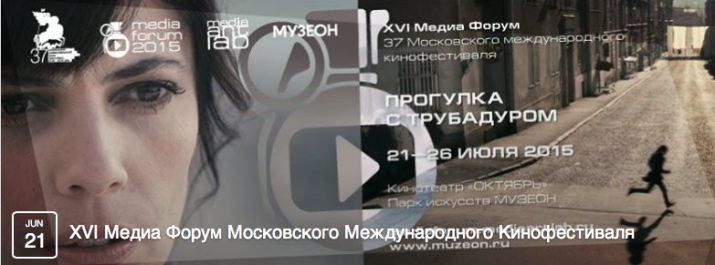Screening dates: June 21—26, 2015.
Venue: Multiplex Cinema October (Novy Arbat St., 24),
Project curator: Olga Shishko (art director of the MIFF Media Forum, director of the Centre for Art And Culture MediaArtLab).
Producer: Elena Rumyantseva (program director of the MIFF Media Forum).
Event Organizers: MediaFest, Centre for Art and Culture MediaArtLab.
Co-organizer: MUZEON Art Park
With support of: Prokhorov Foundation, Swedish International Committee for artists support Jaspis, Embassy of the Kingdom of the Netherlands, Embassy of the United States of America in the Russian Federation, Embassy of the State of Israel in the Russian Federation.
Event participants: Gary Hill (USA), Anri Sala (Albania-France) together with Liria Begeja (France) Angela Ricci Lucchi & Yervant Gianikian (Italy), Anton Ginzburg (Russia-USA), Santiago Sierra (Spain), Yael Bartana (Israel), art group Provmyza (Russia), art group “Boundless expanses” (Russia), Guido van der Werve (Netherlands), Aram Karsi (Russia), Bill Morisson (USA), Johanna Billing (Sweden).
The 2015 Media Forum is bringing several season premieres of international video art celebrities to Moscow, among them — Gary Hill, Yael Bartana, Johanna Billing and art group Provmyza. And works by artists Anri Sala, Santiago Sierra, Guido van der Werve, Bill Morrison and Anton Ginzburg who have been acclaimed by the leading film festivals and museums of the world, such as MoMA in New York, Stedelijk Museum in Amsterdam, film festivals in Locarno, Rotterdam, Manchester, and galleries of London and Berlin.
Video Walk with a Troubadour:
11 works by international stars of video art and artist talks
Video Walk with Troubadour is the Main program of the Media Forum, which will be held on June 21- 26 at the October Movie Theatre. The program explores performative possibilities of sound and its influence on psychological and visual experiences: each of the 11 artists somehow violates the barriers of perception and the spectator’s usual comfort zone. This program is the start of long-term and large-scale interdisciplinary project on sound in contemporary visual culture, which will include workshops, research conference, several exhibitions and educational program in the coming year. The project will continue on through inviting new artists, curators and spaces, with the aim to foster the development of different and alternative views on the topic at future stages.
In the works of the program Video Walk with Troubadour, music, text and images intertwine in a touching, intimate and irrational message, which makes these contemporary artists similar to troubadours – authors of ancient songs. From the moment of its emergence, a song was an imaginative and emotionally charged message, combining melody and lyrics, author’s personal experience and performing style. Medieval troubadours were musicians and poets, keen observers and sincere artists at the same time. They were the first to talk about the world as bearers of high culture, at the same time remaining accessible to common people: they performed their songs both at court and city squares. So troubadours were the first artists for the masses, involving citizens and peasants in the art, previously available only for the elite, behind closed doors.
According to the concept elaborated by Olga Shishko, curator of the program Video Walk with Troubadour, contemporary experimental artists are troubadours of today – nomads and pioneers, authors and narrators at the same time. They work beyond geographic and genre boundaries, combine authors and performers within themselves, reject usual narrative and literal images. They have a colossal potential to tell complex things in a simple way, clear to everyone, address the audience in an intelligible yet lyric language, which is intuitively understood by everyone. Instead of a one-sided narrative of everyday life they offer a lyric allegoric dialogue of sound pieces and visual images, rich in associations and open to interpretation. Their main method of interaction with the audience is through works based on sound, melody, musical fragments, lyrics and poetics of noise.
Invisible and intangible sound, which seems to be a secondary instrument in video and cinema, is in fact the key element of atmosphere and dramaturgy of the moving image since sound film has emerged. The main feature of the sound is a freedom from the viewer’s control. The sound is able to affect inner conditions and provoke emotions independently of our will, to create an alternative narrative, which contravenes what we see and comprehend. Music, text and images in the work of every artist of the program intertwine into a touching intimate experience, unique for every viewer, yet bearing a recognizable author’s manner.
